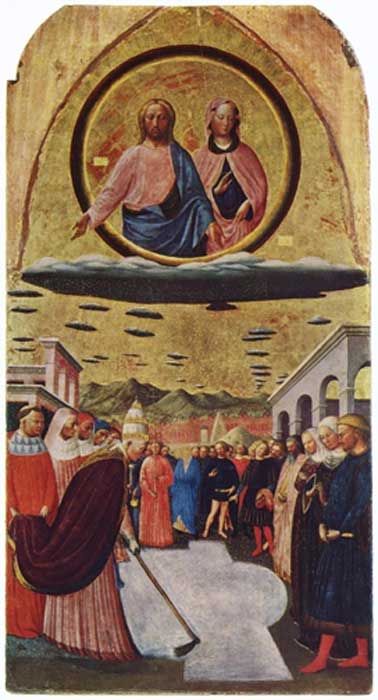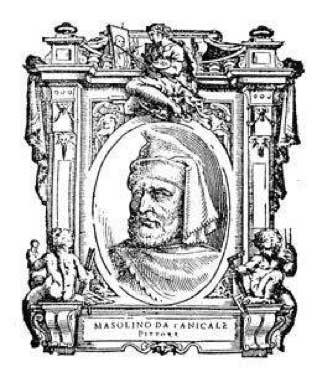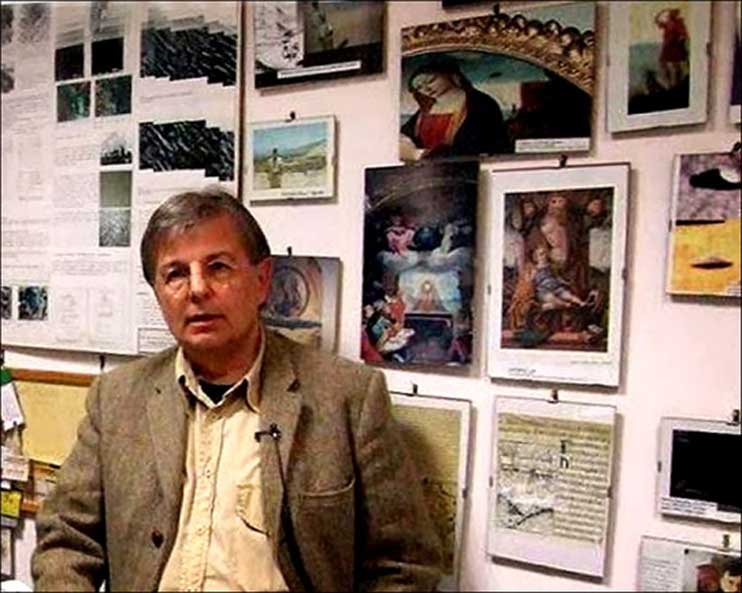
Italian Renaissance Paintings of UFO’s Hidden in Plain Sight
One day in early August in the fourth century AD, something strange happened in Rome. Those who were outside braving the heat, walking on the Esquiline Hill would have glanced at the sky to notice a curious cloud formation - very different certainly from the compact cloud cover typical of snowfall - and would have been astonished to see snowflakes drifting down to earth – in the heat of summer! Some may have fled to escape this manifestation of divine wrath while others may have tentatively stretched out a hand to catch them and see them evaporate like real snowflakes. Someone noted and recorded the event.

The Miracle of the Snow by Masolino da Panicale. Christ and the Blessed Virgin Mary observe Pope Liberius, who marks in the legendary snowfall the outline of the basilica by Masolino da Panicale (Public Domain)
Nine centuries later Bartolomeo da Trento in his 13th-century Liber epilogorum in gesta sanctorum wrote that when the event of the miraculous summer snowfall had occurred in the fourth century, Pope Liberius traced the perimeters for the basilica of Santa Maria Maggiore in the snow on the ground. Two centuries thereafter someone read in the ancient chronicle of Fra’ Bartolomeo from Trento, a description of this strange event and commissioned the artist Masolino da Panicale to paint the Tryptych of the Madonna della Neve.

Masolino da Panicale: Illustration from "Le Vite" by Giorgio Vasari, (1568 edition) (Public Domain)
Madonna Della Neve
Tommaso di Cristoforo Fini, known as Masolino, was born in 1383 in Panicale in Valdelsa. Giorgio Vasari, defined as one of the best rinettatori (cleaners and engravers of bronze tiles used in artistic castings) and in the service of Lorenzo Ghiberti, (a Florentine artist and the creator of the bronze doors of the Florence Baptistery) was in an excellent position to capture the history of contemporary artists in his Lives of the Most Excellent Painters, Sculptors, and Architects. He recorded Masolino began painting in AD 1402, in Florence. In circa AD 1423 at a mature age, he enrolled in the Corporation of Doctors and Speeches, which also included painters since they worked with 'chemical materials' - the pigments used to produce colors. He returned to Florence at 40 years old, after traveling extensively and having spent time in Rome. It was in Rome, perhaps, where he had heard about that 'miracle' which six years later inspired him to paint the Triptych of the “Madonna della Neve in collaboration with Tommaso di Ser Giovanni di Monte Cassai, better known as Masaccio, and the illustrious Paolo Schiavo.
Dr Pinotti in his 1996 Angeli, Dei, Astronavi (Angels, Gods and Spaceships) poses the question how could Masolino da Panicale have dared to describe the sighting of a UFO and summer snow in Rome during an era when everything slightly removed from the acceptable norm would have been regarded as witchcraft or a miracle? The answer lies therein that various artists of the 15th century chose to frame such unconventional themes within a mystical religious dimension.
- What Did the Ancients See? Unidentified Flying Objects that Made an Impact on Early History
- The ancient history of UFOs and the unclassified document of Oppenheim and Einstein
- The Twisted Phenomena and Strange Features of Medieval Art

Dr Roberto Volterri in his study at the university, with behind him a good number of images about strange objects that in the distant past evolved in our skies and that were immortalized by some famous painters (Image: Courtesy Roberto Volterri)




